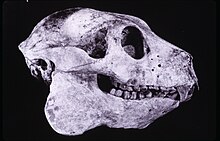Our website is made possible by displaying online advertisements to our visitors.
Please consider supporting us by disabling your ad blocker.
Portal:Madagascar
The Madagascar Portal
Madagascar, officially the Republic of Madagascar, is an island country that includes the island of Madagascar and numerous smaller peripheral islands. Lying off the southeastern coast of Africa, it is the world's fourth largest island (after Greenland, New Guinea, and Borneo), the second-largest island country (after Indonesia), and the 46th largest country overall. Its capital and largest city is Antananarivo. Following the prehistoric breakup of the supercontinent Gondwana, Madagascar split from Africa during the Early Jurassic period, around 180 million years ago, and separated from the Indian subcontinent approximately 90 million years ago. This isolation allowed native plants and animals to evolve in relative seclusion; as a result, Madagascar is a biodiversity hotspot and one of the world's 17 megadiverse countries, with over 90% of its wildlife being endemic. The island has a subtropical to tropical maritime climate. Madagascar was first permanently settled during or before the mid-first millennium AD by Austronesian peoples, presumably arriving on outrigger canoes from present-day Indonesia. These were joined around the ninth century AD by Bantu groups crossing the Mozambique Channel from East Africa. Other groups continued to settle on Madagascar over time, each one making lasting contributions to Malagasy cultural life. Consequently, there are 18 or more classified peoples of Madagascar, the most numerous being the Merina of the central highlands. Until the late 18th century, the island of Madagascar was ruled by a fragmented assortment of shifting sociopolitical alliances. Beginning in the early 19th century, most of it was united and ruled as the Kingdom of Madagascar by a series of Merina nobles. The monarchy was ended in 1897 by the annexation by France, from which Madagascar gained independence in 1960. The country has since undergone four major constitutional periods, termed republics, and has been governed as a constitutional democracy since 1992. Following a political crisis and military coup in 2009, Madagascar underwent a protracted transition towards its fourth and current republic, with constitutional governance being restored in January 2014. (Full article...) This is a Featured article, which represents some of the best content on English Wikipedia..
Babakotia is an extinct genus of medium-sized lemur, or strepsirrhine primate, from Madagascar that contains a single species, Babakotia radofilai. Together with Palaeopropithecus, Archaeoindris, and Mesopropithecus, it forms the family Palaeopropithecidae, commonly known as the sloth lemurs. The name Babakotia comes from the Malagasy name for the indri, babakoto, to which it and all other sloth lemurs are closely related. Due to its mix of morphological traits that show intermediate stages between the slow-moving smaller sloth lemurs and the suspensory large sloth lemurs, it has helped determine the relationship between both groups and the closely related and extinct monkey lemurs. Babakotia radofilai and all other sloth lemurs share many traits with living sloths, demonstrating convergent evolution. It had long forearms, curved digits, and highly mobile hip and ankle joints. Its skull was more heavily built than that of indriids, but not as much as in the larger sloth lemurs. Its dentition is similar to that of all other indriids and sloth lemurs. It lived in the northern part of Madagascar and shared its range with at least two other sloth lemur species, Palaeopropithecus ingens and Mesopropithecus dolichobrachion. Babakotia radofilai was primarily a leaf-eater (folivore), though it also ate fruit and hard seeds. It is known only from subfossil remains and may have died out shortly after the arrival of humans on the island, but not enough radiocarbon dating has been done with this species to know for certain. (Full article...) Selected article -Queen Rafohy (died 1540) was a Vazimba queen who ruled at Alasora in the central Highlands of Madagascar from 1530 until her death in 1540. Her name means "The Short One." She succeeded upon the death of Vazimba Queen Rangita, who by different accounts was either her mother or her adoptive sister. This confusion in the oral tradition extends to the two women's very identities - according to different accounts, Rafohy may have been the mother of Rangita, and Rangita may have been the mother of the famed king Andriamanelo. During Rahofy's reign, Merina influence grew. Her capital was Alisora. (Full article...) This is a Good article, an article that meets a core set of high editorial standards.
 The nelicourvi weaver (Ploceus nelicourvi) is a species of bird in the family Ploceidae. It is endemic to Madagascar. Together with its closest relative, the sakalava weaver, it is sometimes placed in a separate genus Nelicurvius. A slender, sparrow-like bird, it is 15 cm (5.9 in) long and weighing 20–28 g (0.71–0.99 oz). Breeding males have a black bill and head, brown eyes, yellow collar, grey belly, chestnut-brown lower tail coverts, olive back, and blackish flight feathers edged greenish. Non-breeding males have mottled grey and green heads. In the breeding female the front of the head is yellow and the back olive green, with a broad yellow eyebrow. It builds solitary, roofed, retort-shaped nests, hanging by a rope from a branch, vine or bamboo stem, in an open space. It primarily feeds on insects, looking on its own or in very small groups, often together with long-billed bernieria. Its natural habitat is subtropical or tropical moist lowland and mountain forests. The conservation status of Nelicourvi weaver is least concern according to the IUCN Red List. (Full article...) General images -The following are images from various Madagascar-related articles on Wikipedia.
Selected panoramaRice fields near Ambalandingana, Madagascar.
TopicsCategoriesSelected pictureAssociated WikimediaThe following Wikimedia Foundation sister projects provide more on this subject:
Discover Wikipedia using portals | |||
Previous Page Next Page















































































